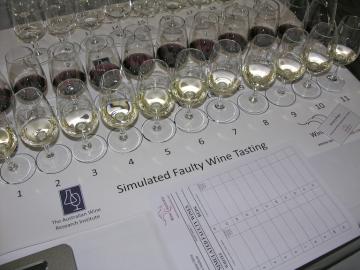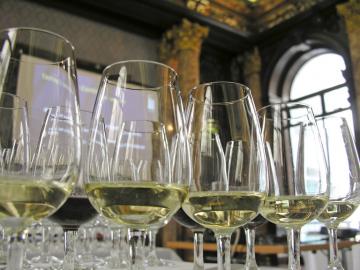What's Your Poison
POSTED ON 17/07/2009It’s not normally the job of this column to regale you with the horror stories of wines tasted on your behalf so that you don’t have to. While wine writing is the job everyone except my teetotal aunt wants, especially those who don’t regard it as a job at all, it does have its pitfalls, and weeding out the sheep from the goats is one of them. So it was that along with a group of journalists, educators and wine trade buyers, I found nose, palate and ego being road-tested on a challenging wine course put on by the Australian Wine Research Institute (AWRI) aimed at training Australian wine show judges.
 Fault lines
Fault lines
As a prelude to the big test Con Simos, the course instructor, reminded us that the stats from one of last year’s biggest consumer competitions showed more than six in every 100 wines as faulty. Of those six-plus bottles, three suffered from cork taint, 1.5 from wine’s equivalent of athlete’s foot, known as brettanomyces, or brett. Knowing your onions then, or at least being able to sniff them out, was a pre-requisite for the job in hand.
In the morning session, the AWRI had kindly spiked 11 white and 11 red wines with chemicals representing the commonest wine faults, except for one unspiked wine to see if we could spot the clean one. Actually Mr.Simos suggested we didn’t taste the wines but just smell them, a good idea given the number of horrors that emerged. These were wines, no part of which you would wish to put anywhere inside your body.
Cork taint, or TCA, was there, as expected, giving off a mouldy cardboard aroma, but also a wine smelling corked, but with a screwcap. This was thanks to a similar compound, TBA, an infection from warehouses and cellars. We also found brett, the character giving off a horsey odour, a problem rife in ripe wines with high levels of alcohol coming into contact with oak. And so it went on: bruised apples and pears smells from acetaldehyde, caged mice from a mousy compound, geranium from sorbic acid, onions from mercaptan, rotten egg from hydrogen sulphide, nail polish remover from ethyl acetate and vinegar from acetic acid.
 Downer Room, Australia House
Downer Room, Australia House
Cork taint has a zero tolerance, but brett, and some other faults, have a threshold of acceptability. In fact, some people even seem to like a bit of horse in their wine. The dividing line between what’s acceptable and what’s not can be a subjective one and it was interesting to see that some tasters are more susceptible to certain taints than others. I’m sensitive to cork taint for instance, less so to sulphur, which has some tasters gasping and coughing like asthma victims.
The rest of the day was spent testing the accuracy of our palates by blind tasting, evaluating and scoring 20 white wines and 20 reds that had been awarded a gold, silver, bronze medal or commended in this year’s International Wine Challenge. So far so good, until we found out that each wine was repeated. Since each wine had its pair in both whites and reds, our suitability as judges depended on how consistently we were able to match each wine with its pair. The AWRI took away our scores to let us know if we passed our MoT (Master of Tasting). A daunting prospect, the results of which I promise to put up on my site.
See results and AWRI letter below.
Something for the Weekend
Under a Fiver
2008 Tesco Finest Nero d’Avola.
From the giant Settesoli Co-operative in Sicily, this is barbecue heaven, a delightful cherryish rosso whose softly juicy, summer pudding fruit is just what’s required to make the barbie go with a zing. £4.49, down from £5.99 until Tuesday, Tesco.
Under a Tenner
2007 Val do Salnés Albariño.
From Spain’s Galician coast on the Atlantic, the aromatic, peachy richness of flavour of this stylish albariño is tempered by the sort of refreshingly crisp acidity that marks it out as a classic seafood-friendly dry white. £9.99, Marks & Spencer
Splash Out
2007 Henschke Louis Semillon, Eden Valley.
Scented with lemony tropical notes, the apple and gooseberry-like concentration of this classic cool climate Australian semillon from the Henschke family of Hill of Grace fame is balanced by a quinine-like tonic freshness and intensity of flavour. £12.99, Waitrose.
The AWRI letter
Dear Anthony,
Following your participation in the recent Wine Assessment Tasting, please find attached the results of the statistical analysis of your tasting scores. To ensure confidentiality, each participant has been randomly allocated a judge number. Your judge number is 20.
As explained during the tasting, the analysis was performed on the scores given to all white and red table wines that were repeated, except where one of the bottles was assessed by several participants as being affected by cork taint or other significant problem.
Note that several factors will have had an impact on your performance. This analysis gives a ‘snapshot’ of your performance, which can and will vary both from one tasting event to another and from one style to another. Caution should be used in interpreting the results without a full understanding of the system and the limitations of the tasting regime used. Use these figures as a guide—they are not necessarily the full story of your tasting skills. Nevertheless, it is a useful exercise to spend some time comparing the indices of your performance with that of the rest of the group.
Your performance has been described by two parameters, summarised briefly below. The attached sheet shows the results, in random order, of all participants.
Reliability is a measure of scoring consistency, or the ability of a judge to reproduce results on different occasions. A value close to +1 indicates good consistency, a score close to 0 indicates a random scoring pattern, and a score close to –1 indicates that the score given on one occasion was the opposite of that given on another. In the context of the scores given, the higher the number, the better.
Average Absolute Difference (AAD) is an alternative and perhaps more straightforward measure of consistency. It is the average difference between scores given to wines on repeat tastings. For example, an AAD of 1 means that, on average, a person scored the repeat wines differently in either direction by 1 point. Therefore, the lower the score the better, with less than 1.5 being desirable.
Please contact myself or Richard Gawel (richard.gawel@awri.com.au) if you would like to discuss these results.
Thank you for your participation in the course, we hope that you found this tasting educational and interesting.
Yours sincerely,
Con Simos
Course Leader
Judge Reliability AAD
1 0.06 3.6
2 0.33 4.1
3 0.51 4.4
4 0.7 2.2
5 0.25 4.2
6 0.5 4.1
7 0.29 8.3
8 0.42 3.2
9 0.75 1.8
10 0.78 2.5
11 0.29 3.9
12 0.6 2.7
13 0.11 5.9
14 -0.03 8
15 0.58 3.5
16 0.23 3.3
17 0.53 3.4
18 0.44 4.2
19 0.56 2.8
20 0.53 2.8
21 0.16 5.9
22 0.12 4
23 0.06 4.2
24 0.19 3.8
25 0.29 4.3
26 0.2 4.8
27 0.23 4.9
28 0.45 4.4
29 0.05 4.8
30 -0.17 4.5

